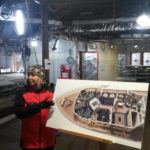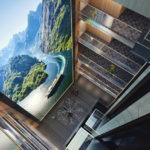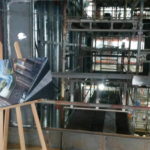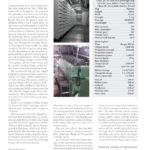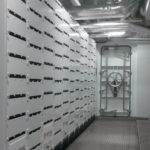With the »Roald Amundsen« the shipping company Hurtigruten wants to set new cruise standards. The project actually has the potential for this, even if patience is still required
in one a crucial point. By Michael Meyer
Many, many things should be innovative and sustainable according to the ideas of ship owner Daniel Skjeldam. The CEO and[ds_preview] former top manager of the low-cost airline Norwegian, who has been in office since 2012, brings all his enthusiasm and persuasiveness to bear when he talks about the two new polar cruise ships »Roald Amundsen« and »Fridtjof Nansen«. The ships are built at the Norwegian Kleven shipyard – today a 100% daughter of Hurtigruten. For the presentation of the ships, he has brought support from his team, from the shipyard and from the most important supplier Rolls-Royce to the west coast of Norway.
When the two ships were ordered – there is a letter of intent for a third one – it was said to be the largest single investment in the history of the shipping company, according to reports 130mill. $ per ship. Shortly afterwards, in July 2016, Rolls-Royce was commissioned to develop and supply design and equipment for around 33mill. $.
The chosen design combines an ice-strengthened hull with a wave piercing bow design, developed in cooperation with Espen Oeino from Monaco. Part of the package is Rolls-Royce’s »Unified Bridge« with entirely redesigned consoles, levers and software interfaces. For operations at sea, the ships will be equipped with a DP0 dynamic positioning system, Aquarius 100 stabilisers and an ACON integrated automation system. According to the supplier, the onboard hybrid power solution in combination with the hull structure and what is said to be efficient electric power systems will reduce the fuel consumption by approximately 20% and CO2 emissions by 20%, which is equivalent to more than 3,000 t of CO2 per annum.
The propulsion system is the nucleus for the technologically wise innovative character of the newbuilding with a range of 6,000 nm: A hybrid system, consisting of a diesel-electric engine and a battery pack of Canadian market leader Corvus Energy. All engine rooms are separated and working with independent energy systems.
The battery system will be used primarily for peak shaving, i.e. to cover consumption peaks so no second generator has to be switched on. The 1,3 MW batteries will be charged by rest-power of the generator when not in use and they can principally supply different tasks on board. However, the battery room was designed with a much larger space, so the system can be expanded to 6,4 MWh. »There would be space for up to five times as many batteries. Whether and when we increase it depends on the development of the technology. But we assume that it will soon be three times as effective as it is today,« says Hurtigruten manager Thomas Westergaard. In principle, the ships would also be able to operate purely electrically, depending on the installed capacity and the respective itinerary specifics. Corvus delivered its »Orca« lithium ion based energy storage systems (ESS). The supplier said the cruise vessels will be capable of sailing silently on ESS battery power alone into pristine locations.
The vessels will also get two azipull propellers using permanent magnet technology, two large 1.5 MW tunnel thrusters with electrical PM motors, stabilisers and four Bergen B33:45 engines. Rolls-Royce says, these will have a selective catalytic reduction (SCR) system to meet the IMO Tier III nitrogen-oxide (NOx) emission limits. All in all, there is a reduction of 2,222t CO2 and 44t NOx, each representing 14%.
There is an emergency bridge system on board the ships including »safe return to port« facilities with a range of 1,000 nm.
Other partners from the supplier industry include Brombach & Gess, insulation specialist Isover, PCMulti, the Dutch specialist for plastic applications Bolidt, DeRossi, MPE Cathodic, Sperre Marine, Scanship/Polymore, Alfa Laval, Watergates GmbH, the electronics group Siemens, Intersam or the companies Börger Pumpen, Schneider Electric and last but not least Essen-based ThyssenKrupp Group with its elevator division.
Scientific focus
Besides the – undoubtedly important – general equipment on board, which should not be missing on any cruise ship, Hurtigruten wants to make a step to the side with its newbuildings, in the direction of science. There are cooperations with research institutions such as the Norwegian Polar Institute. Scientific equipment is taken on board and set down in the Antarctic. The shipping company believes that this could at least partially replace the expensive use of research vessels.
The crew also collects their own data, carries out surveys, conducts research. Even underwater drones will be used for scientific works.
Karin Strand, Field Operations Manager at Hurtigruten has ambitious plans: »My dream is that one day we can publish research papers based on our work on the ships«. She wants to operate a floating university of the future. There are entire areas on board for this, including a science centre with laboratory and lecture hall, where crew and passengers can work together when they return from a shore excursion, where they explore nature, hike to penguin colonies or collect data. The ship will also feature several restaurants with special interior design, a shop, a photo centre, a library, internet facilities, a compass service centre as well as outdoor walking and explorer decks.
A very special feature is a what Hurtigruten calls the »worlds largest LED screen on a ship«. It is 17.5m high and 6.5m wide, spreading over seven decks. Passengers can be shown either artificial pictures or a view on the surrounding oceanic nature.
Room for ecological improvement
After some delays, the »Roald Amundsen« and »Fridtjof Nansen« are to be delivered in the 1st quarter and towards the end of the 3rd quarter of 2019. From Norway over Lisbon, the first newbuilding will sail to Hamburg – »Germany is our largest market«, Skjeldam says – , and Kirkenes before taking the Northwest Passage in the Arctic and going via Vancouver to the Antarctic region. Hurtigruten is already working on further newbuildings: »But it is not yet clear when and where they will be built,« Skjeldam tells HANSA. He does not reveal details about ship type and propulsion technology or a possible timetable for the time being.
However, it is relatively clear that possible newbuildings will exploit the potential for environmentally friendly fuels even better than »Roald Amundsen« and »Fridtjof Nansen«.
The company has already invested heavily in sustainable technologies such as battery solutions, and now plans to convert fish waste into liquid biogas (LBG) and use it as fuel. By 2021, biogas combined with LNG is to be used on six ships to operate the battery system.
Neither have any orders yet been awarded for the already announced LNG hybrid propulsion systems conversions of up to nine existing Hurtigruten vessels.
»Roald Amundsen« and »Fridtjof Nansen« do not get an LNG system at first. In terms of battery potential, further technological development will also be used, in combination with gas propulsion systems »the best option we currently have,« says Skjeldam. Hydrogen is also very interesting, but »in the future«. For him, scrubbers are not an option at all. Asked about LNG, he stresses that Hurtigruten would also be very interested in these two ships. However, the area of operation is putting a spoke in the wheel: »It will happen, but on our routes there are definitely too few possibilities to bunker LNG. That’s why we had to decide against it,« says the shipowner’s chief of staff. A stronger integration of biogas must also wait. The industry produces too little of it, says the manager.
Michael Meyer






